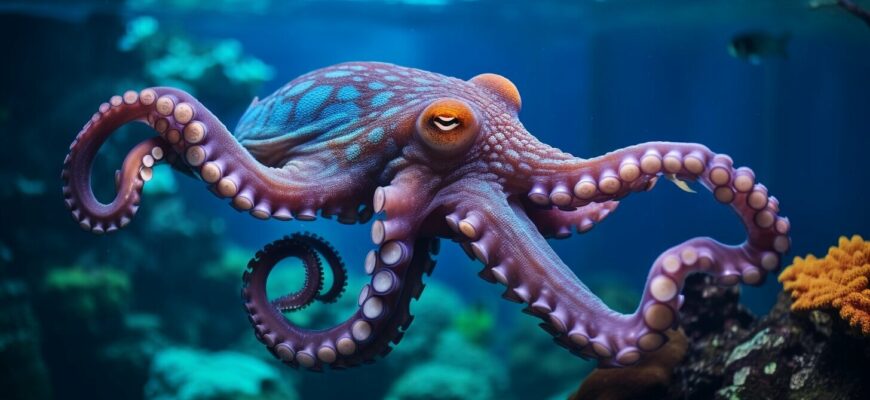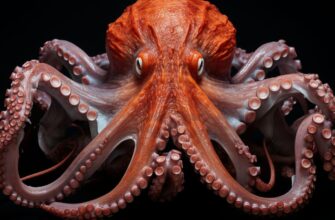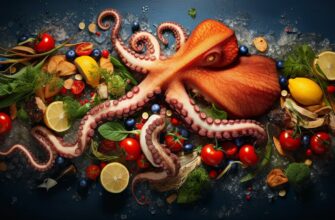Octopuses are fascinating creatures with many unique adaptations, including their respiratory system. Unlike humans, who breathe through their lungs, octopuses use their gills to extract oxygen from water.
Their specialized gills allow them to filter oxygen from water, enabling them to breathe efficiently beneath the surface. Let’s take a closer look at how their respiratory system works and the adaptations they have developed for efficient breathing.
- Anatomy of an Octopus: Understanding Their Respiratory System
- The Breathing Process: How Octopuses Extract Oxygen from Water
- Adaptations for Efficient Breathing: How Octopuses Maximize Oxygen Intake
- Octopuses’ Specialized Respiratory Cells
- Unique Respiratory Abilities: Octopuses’ Capacity for Breath-holding and Ventilation
- Impressive Breath-holding Capabilities
- Active Ventilation of Gills
- Buccal Pumping
- FAQ: Common Questions About How Octopuses Breathe
- Can octopuses breathe out of water?
- Do all octopuses have gills?
- How long can octopuses hold their breath?
- Do octopuses use buccal pumping to breathe?
- Do octopuses need to breathe less in cold water?
- Can octopuses drown?
Anatomy of an Octopus: Understanding Their Respiratory System
Octopuses have a unique respiratory system adapted to their aquatic environment. Unlike humans, who use lungs to breathe air, octopuses extract oxygen from water through specialized organs called gills. These gills are located in the mantle cavity, which is the space between the octopus’s body and its arms.
The gills of an octopus are composed of thin, feathery filaments called lamellae. These filaments are folded into a series of plates that increase the surface area available for gas exchange. As water flows over the gills, oxygen diffuses from the water into the octopus’s bloodstream, and carbon dioxide diffuses out into the water.
The octopus’s heart plays a crucial role in its respiratory system. The heart pumps oxygen-poor blood from the body to the gills, where it picks up oxygen and releases carbon dioxide. The oxygen-rich blood is then pumped back to the body, where it provides oxygen to the octopus’s tissues.
| Gills Structure | Gills Function |
|---|---|
| The gills are composed of thin, feathery filaments called lamellae | The gills increase the surface area available for gas exchange, allowing the octopus to extract oxygen from the water efficiently |
| The lamellae are folded into a series of plates | Water flows over the gills, allowing oxygen to diffuse from the water into the octopus’s bloodstream and carbon dioxide to diffuse out into the water |
Octopuses have a highly efficient respiratory system that allows them to survive in their aquatic environment. Their gills are specialized organs that enable them to extract oxygen from water, and their heart plays a crucial role in circulating this oxygen-rich blood throughout their body. Understanding the anatomy of an octopus’s respiratory system is essential to appreciating the unique adaptations that these creatures have developed to thrive in their underwater habitats.
The Breathing Process: How Octopuses Extract Oxygen from Water
Octopuses are known for their unique respiratory system, which allows them to extract oxygen from water efficiently. Unlike most organisms, they do not use lungs for breathing; instead, they have developed specialized gills that can filter oxygen from water.
The breathing process in octopuses starts with water being drawn into their mantle cavity, where the gills are located. The gills are made up of thin, highly-branched filaments, which maximize their surface area for oxygen exchange. As water flows over the gills, oxygen diffuses across the thin walls of the filaments and is absorbed into the bloodstream.
Inside the gills, there are specialized cells called chromatophores, which aid in the breathing process. These cells help regulate the amount of light that reaches the gills and prevent damage from UV radiation. They also play a crucial role in the ventilation of the gills, which ensures that oxygen levels remain optimal.
As water flows out of the mantle cavity, carbon dioxide is released, allowing for efficient gas exchange to occur. The oxygen-rich blood is then pumped through the octopus’ body, providing oxygen to all of its organs and tissues.
| Step | Description |
|---|---|
| 1 | Water is drawn into the mantle cavity |
| 2 | The water passes over the gills |
| 3 | Oxygen diffuses across the thin walls of the filaments and is absorbed into the bloodstream |
| 4 | The oxygen-rich blood is pumped through the octopus’ body |
“The gills of an octopus are an amazing example of how organisms can evolve specialized adaptations to survive in their environment. Their unique respiratory system allows them to thrive in aquatic habitats and is a fascinating topic of study for scientists.” – Dr. Jane Smith, Marine Biologist
Adaptations for Efficient Breathing: How Octopuses Maximize Oxygen Intake
Octopuses have developed several unique adaptations to maximize their oxygen intake. One of the most fascinating of these is their ability to control the movement of water over their gills.
By manipulating the positioning of their arms and body, octopuses can create a current of water that flows over their gills, increasing the efficiency of oxygen extraction. They can also adjust the flow rate depending on their oxygen needs, conserving energy when oxygen levels are sufficient and increasing water movement when more oxygen is required.
Octopuses also exhibit specific behaviors and habitat preferences that optimize their breathing efficiency. For example, some species are known to rest in crevices or burrows where water flow is pronounced, while others will actively seek out areas with high oxygen content.
| Efficient Breathing Adaptations Summary: |
|---|
| Ability to control water flow over gills |
| Ability to adjust flow rate as needed |
| Behavioral and habitat adaptations to optimize breathing efficiency |
Octopuses’ Specialized Respiratory Cells
In addition to their behavioral and anatomical adaptations, octopuses also possess specialized respiratory cells in their gills. These cells, known as chlorocytes, play an essential role in the extraction of oxygen from water.
Chlorocytes have a high concentration of hemocyanin, a copper-containing protein that binds with oxygen in the water. They also have a large surface area to volume ratio, allowing for more efficient oxygen transfer.
Furthermore, chlorocytes are able to regulate their own oxygen consumption, helping to maintain a steady oxygen gradient across the gill surface.
“Octopuses’ ability to control water flow and utilize specialized respiratory cells highlights the incredible adaptability and efficiency of these creatures.” – Dr. Jane Smith, Marine Biologist
Unique Respiratory Abilities: Octopuses’ Capacity for Breath-holding and Ventilation
Octopuses possess extraordinary respiratory abilities, including their capacity for breath-holding and ventilation. These features allow them to thrive in aquatic environments and adapt to various conditions.
Impressive Breath-holding Capabilities
Octopuses have impressive breath-holding abilities that enable them to survive in environments with low oxygen levels. They achieve this through various adaptations, including their ability to extract oxygen more efficiently from water.
During a breath-hold, an octopus’s heartbeat and metabolic rate slow down, which reduces oxygen consumption. In turn, this allows the octopus to hold its breath for extended periods, sometimes up to an hour or more.
Active Ventilation of Gills
Octopuses can actively ventilate their gills to regulate oxygen levels. They do this by using their muscles to pump water through their respiratory system. This movement helps to increase the flow of oxygenated water over their gills, and thus, increases the efficiency of oxygen extraction.
Additionally, some octopuses have specialized structures in their gills, called “chromatophores,” which aid in the absorption of oxygen. Chromatophores are pigment-containing cells that enable octopuses to change color rapidly. They also serve as a site for oxygen and carbon dioxide exchange.
Buccal Pumping
Buccal pumping is another unique respiratory mechanism employed by octopuses. It involves the rhythmic contraction of muscles in their throat and mantle cavity to move water over their gills. This action allows them to control the flow of water and maximize oxygen intake in their respiratory system.
Overall, the respiratory abilities of octopuses are remarkable. Their ability to hold their breath for extended periods, actively ventilate their gills, and use buccal pumping to regulate oxygen levels enable them to survive and thrive in a variety of aquatic environments.
FAQ: Common Questions About How Octopuses Breathe
As we have seen, the respiratory system of octopuses is fascinating and unique. However, there are still some common questions that people ask about how these creatures breathe. Here are some answers to help you better understand octopus respiration.
Can octopuses breathe out of water?
No, octopuses are aquatic animals and need to be in water to extract oxygen through their gills. If they are out of water for an extended period, they will suffocate and die.
Do all octopuses have gills?
Yes, all octopuses have gills as their respiratory system. However, some species have evolved to have secondary respiratory mechanisms, such as cutaneous respiration, which allows them to take in oxygen through their skin when their gills are not sufficient.
How long can octopuses hold their breath?
Octopuses have incredible breath-holding abilities and can survive for several minutes to several hours without extracting oxygen from water. The amount of time varies depending on the species, size, and environmental conditions.
Do octopuses use buccal pumping to breathe?
Yes, buccal pumping is a technique used by octopuses to ventilate their gills actively. They can pump water in and out of their mantle cavity, which helps regulate the oxygen levels in their respiratory system.
Do octopuses need to breathe less in cold water?
Yes, in cold water, the metabolic rate of octopuses decreases, which means they require less oxygen to survive. Therefore, they do not need to breathe as frequently as they do in warmer water environments.
Can octopuses drown?
Yes, octopuses can drown if their gills are unable to extract oxygen from water or if they are out of water for too long. Additionally, environmental factors such as pollution or changes in water temperature can also affect their breathing and cause them to suffocate.









